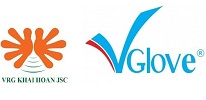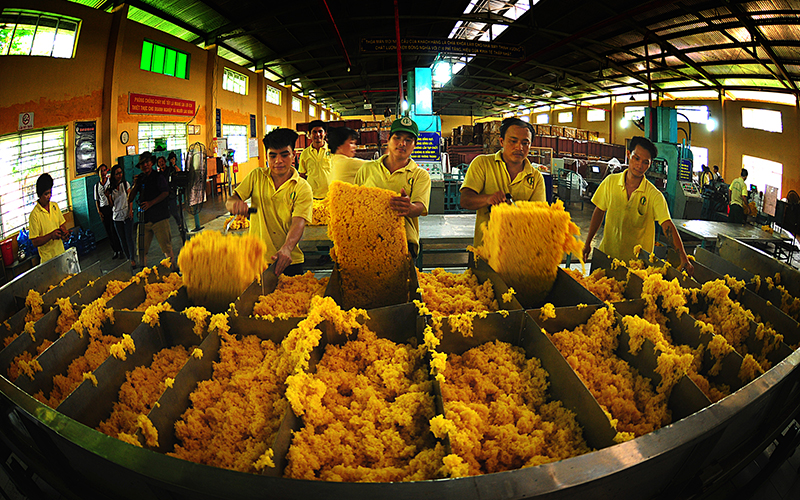Build a product value chain
After more than 100 years of development, the rubber industry is now one of the most important agricultural production sectors of Vietnam, with significant socio-economic and environmental significance. Rubber trees have been planted in all parts of the country, invested in Laos and Cambodia, contributing to social security, especially in remote and ethnic minority areas. Being the largest industrial tree in the country with a total area of over 940 thousand hectares, the annual rubber export turnover is more than two billion USD. In order to make a greater contribution to the industrialization and modernization of the country, the rubber industry is making efforts to restructure, create a new resilience, and rise strongly.
Improve technology, increase productivity
In the past 10 years, Vietnam has been at the top in latex yield, with an average of 1.67 tons to 1.72 tons/ha/year. In 2019, among the top seven countries with natural rubber latex production and productivity, Vietnam reached the highest level of 1.67 tons/ha/year, the second place was Thailand with 1.48 tons/ha/year, followed by Malaysia 1.46 tons, India 1.44 tons, Cambodia 1.15 tons, Indonesia and China, approximately. 1 ton / ha / year. In 2020, the Association of Natural Rubber Producing Countries (ANRPC) assesses that Vietnam continues to be the leading country in latex productivity.
Member of the Board of Directors of VRG Group Ha Van Khuong shared: “The above-mentioned achievements are due to the continuous efforts of the management system of the entire rubber industry, the right long-term orientation policies for development. It is also the result of serious and synchronous scientific research on seed quality improvement, cultivation and gardening techniques, latex harvesting techniques … VRG Group promptly issued The seed structure is suitable for the practice The high yielding varieties mainly under the RRIV brand name are researched and tested by the Vietnam Rubber Research Institute (under VRG). The tree density has been improved, the quality of the orchard is more and more uniform. The latex harvesting regime is also constantly improved to flexibly apply to each region, each working condition. could be D3, D4 to D6, which means three, four, or six shave days at a time. ”
According to the analysis of Mr. Ha Van Khuong, Vietnam has many advantages over other countries thanks to the majority of rubber plantation areas. The whole country currently has more than 940 thousand hectares of rubber, of which, rubber plantation managed by VRG is nearly 300,000 hectares, accounting for more than 30%. This area is strictly and systematically managed according to the technical procedures (QKT) 2012 and most recently, Economic Administration 2020. Many units outside the group or rubber smallholders in the vicinity are also at the same time study and apply the general guidance on economic management that the Group has issued. In addition to effective management and business in rubber areas, VRG also supports science, technology, new rubber varieties for other sectors involved in production and trading. This contributes to improving the productivity and efficiency of production and general business of the rubber industry in Vietnam.
VRG currently has 12 member companies, 80 farms belonging to the list of “Two Ton Club”. VRG’s member rubber companies maintained the highest productivity, which can be mentioned as Phuoc Hoa, Phu Rieng, Dong Phu, Tay Ninh for more than 10 consecutive years in the “Two Ton Club”. And rubber companies such as Binh Long, Loc Ninh, Dau Tieng, Tan Bien, Binh Thuan, Kon Tum for more than 5 consecutive years are in the “Two Ton Club”.
Phuoc Hoa Rubber Joint Stock Company (Phu Giao District, Binh Duong) manages more than 15.5 thousand hectares of rubber, of which the area of rubber plantations for business in 2020 is 6.52 thousand hectares. To improve productivity, the company implements shaving facial planning solutions to maximize the latex mobilization area on the shaving mouth, creating a basis for high and sustainable productivity. In addition, the company applies technical innovations to the orchard such as attaching rain gutter, two-in-one rain shading to help to shield the shaving face, helping to reduce the impact of rain … Along with that is to maintain the emulation movement “Practice skills, compete for skilled workers in harvesting rubber latex”. Since then, the skill level of workers has been raised, labor productivity, garden productivity, and product quality have increased annually. In 2019, the whole company achieved productivity of more than two tons/ha. This is the 15th consecutive year the company has had a yield of more than two tons/ha. In 2020, the company strives to continue to keep the productivity of more than two tons/ha, complete the plan of 11.5 thousand tons of latex.
Director of Tan Lap Farm, Dong Phu Rubber Joint Stock Company (Dong Phu District, Binh Phuoc) Hoang Kim Bao shared his experience in maintaining the farm’s garden productivity of more than two tons/ha over the past years must have a suitable seed structure, reasonable annual tree liquidation rate (liquidated area and newly opened area are equal). In addition, the task of protecting security and order must be well performed, preventing the theft of latex. It is more important to keep the workforce stable by taking care of the workers’ lives and improving their skills.
Diversify the product chain
Vietnam has the highest rubber yield advantage in the world, but according to experts, it is only a necessary factor, not enough to create a competitive advantage over other countries’ products. The sufficient factor is to extend the product chain from agriculture to the production of high-value rubber industrial products and the provision of services to this chain.
From that request, in addition to the rubber sector, VRG also focuses its resources on developing other areas approved by the Government, including Wood processing, industrial zones, and the rubber industry. These fields are operating effectively, contributing significantly to VRG’s the production and business results. VRG’s main wood products include preliminary processing, laminating, refining, and MDF. Since 2016, the wood processing factories have continued to be invested by VRG to expand. By 2019, VRG has 20 wood production factories with a total design capacity of about 1.12 million m3 / year; VRG’s total revenue from wood companies reached more than 31.9 trillion VND; profit before tax more than 3.5 trillion; profit after tax 1.9 trillion.
In the rubber industry, VRG has five rubber industry companies that produce products: medical gloves, conveyors, technical rubber of all kinds, mattresses, rubber pillows, body balls. sports, elastic …, has contributed significantly to the revenue of the whole group. Over the years, the medical glove products of VRG Khai Hoan JSC, which has a factory in Binh Duong, have affirmed its international VGlove brand, conquered difficult markets, and brought in very significant foreign currency. Currently, the demand for medical gloves worldwide has increased due to the Covid-19 epidemic. In order to timely meet the signed orders, factories must run at full capacity 24/24 hours. More than 1,300 workers take turns working three shifts continuously. Deputy General Director Duong Duy Phu, in charge of operating VRG Khai Hoan Joint Stock Company, said: “Annually, the company consumes about 13 thousand to 15 thousand tons of rubber latex material from other units. On average, the company produces more than 220,000 barrels (equivalent to 220 million gloves) per month, of which 80 to 85% of the output is for exports to the US, EU, Japan, and South Korea. , Australia, Russia … Thanks to the application of good manufacturing practices and international certifications, the company’s products meet the requirements of the most demanding markets, with both latex and nitrile examination gloves. signed export contracts for the year 2021. It is expected that this year, the company’s revenue will increase to 80 million USD compared with the average of 40 to 50 million USD in the previous years.
Since 2017, the group has developed truck tires branded VRG, products that meet Japan’s JIS D4230 standard and the national standard TCVN 7533: 2005. In 2018, 1,680 sets of truck tires were consumed by group companies and received good feedback on quality. In 2019, VRG continues to produce 80,000 tires with 15 types, suitable for many different models. Tire products are recognized for international quality with competitive prices, 15% cheaper than products of other brands … Particularly products such as Sports balls bearing the Star Geru brand; Dong Phu mattress, and pillow have been highly appreciated by domestic and foreign customers. Enterprises have mastered advanced technologies, products meeting export standards. In particular, the sports ball of Geru Star Sports Joint Stock Company is very popular among G7 countries, Japan. On average, each month, the company has an export turnover of 70,000 to 80,000 USD to difficult markets.
Vietnam has an outstanding rubber latex yield compared to other countries. But in order to improve production efficiency and create a competitive strength for Vietnamese rubber products in the international arena, the most important factor is to build a product value chain. Although Vietnam Rubber Industry Group (VRG) accounts for only about 30% of the country’s rubber area, it plays a key role in promoting the development of the rubber industry.
According to the Chairman of Binh Phuoc Provincial People’s Committee Tran Tue Hien, Binh Phuoc currently ranks first in the country in the area of rubber trees with more than 220 thousand hectares, accounting for 22% of the country’s rubber area, of which more than 70 thousand hectares. state-owned enterprises. Rubber enterprises in the province create jobs for more than 24 thousand workers; the average income is from 5.5 to more than 9.5 million / person/month. In addition to traditional fields, companies also diversify industries, expand investment effectively in many fields such as high-tech agriculture, development of industrial parks, residential areas, and trading in the wood industry. .. Over the past years, Binh Phuoc has always ensured annual growth of more than 7.5% and can affirm that the province’s development has made a great contribution to the rubber industry.


